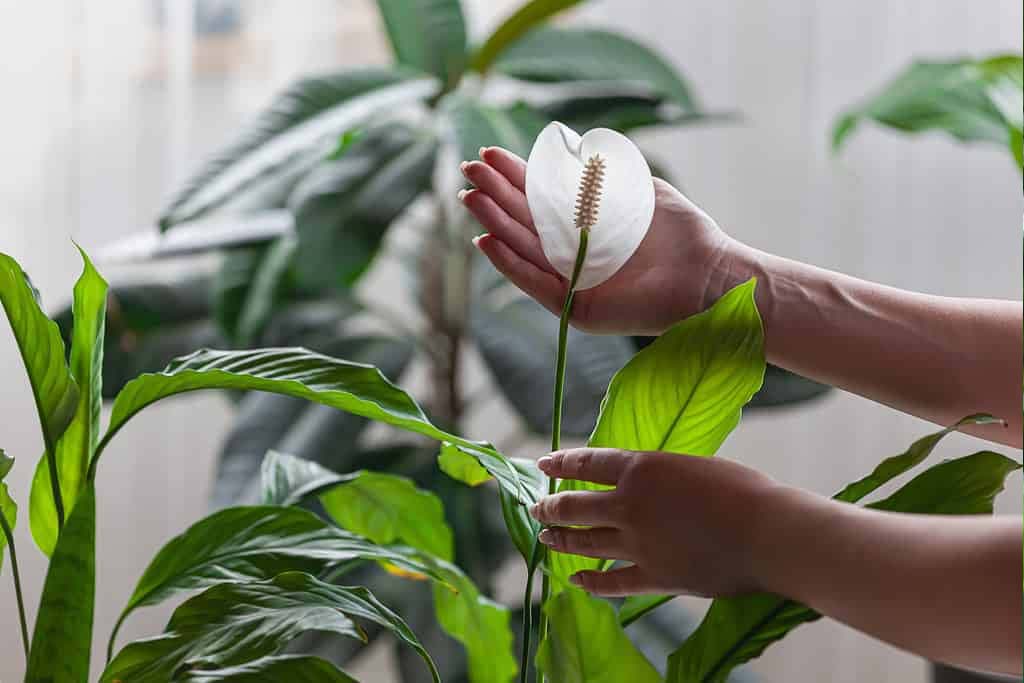Peace lily disadvantages
Peace lilies, popular houseplants due to their white flowers and low light requirements, can be challenging to grow for beginners. They can become drama queens when water levels drop, causing them to ‘faint’ their leaves. If your peace lily is dying or not doing well, it’s important to understand the common problems, their solutions, and prevention methods. This will help you understand the root cause of the issue and provide a more effective solution.
This page provides information on caring for a peace lily, but only covers potential problems and diagnoses. For more details on light, potting, watering, and more, visit the peace lily care guide.
What is a Peace Lily Plant?
Peace lilies are tropical, evergreen plants native to tropical Central and South America, thriving on forest floor conditions. They produce white to off-white flowers in early summer and continue to bloom throughout the year in the right conditions. Most household varieties grow up to 16 inches tall, while larger outdoor cultivars can reach up to 6 feet. Peace lilies are not cold-hardy, so they can only be grown outdoors in warm, humid climates (USDA Zones 10, 11). Replicating these conditions in the home is crucial for their health and happiness.
Characteristics of Peace Lily Plant
Indoor flower plants are popular among those who love flowers. These plants thrive in various conditions and offer numerous benefits. The peace lily is a popular choice due to its low maintenance and showy appearance. Studies have shown that these plants are beneficial for various reasons, making them a great addition to any home.
1. It purifies the air: Air purification is crucial for human health, as homes contain numerous pollutants that cause health issues. Proper ventilation and removing sources of these pollutants can control harmful gases and VOCs. House plants like peace lily’s, also known as cobra plants, can help reduce these pollutants. NASA experiment showed that peace lily plants can absorb pollutants like benzene, xylene, carbon monoxide, and formaldehyde, eliminating 60% of them. This process also adds moisture to the air, making it suitable for breathing. Overall, proper air purification and ventilation are essential for maintaining good health.
2. It’s a low maintenance house plant: Many people prefer low-maintenance indoor plants for their busy schedules. The peace lily is an excellent choice due to its ability to survive without sunlight and use bright indoor light from indirect sunlight. Its glossy green leaves and big white bracts make it an attractive indoor plant. With its low requirements, many indoor plant growers choose the peace lily as their top choice.
3. Absorbs acetone vapors: The peace lily plant not only protects against external pollutants but also helps prevent harmful vapors from home products like varnishes, paints, rubbing alcohol, and nail polish removers, which can cause health issues like headaches, coordination issues, low blood pressure, acetone poisoning, and lethargy. Keeping a peace lily in your home helps keep the air free from these harmful vapors, making it a healthier environment for you.
4. Promotes restful sleep: Indoor plants are beneficial for insomnia and poor sleep, as they filter indoor air, increase humidity levels, and improve breathing. They also absorb common allergens like mold spores, aiding in good sleep. The beauty of these plants brings calmness and alleviates stress. According to Feng Shui, they are the best bedroom plant, as they bring positive energy and a peaceful touch to the room. Overall, indoor plants are an excellent choice for promoting restful sleep and overall well-being.
5. Perfect to spruce up home décor: This indoor plant offers numerous health benefits and adds beauty to any space. Its curved bract white flowers and green foliage make it a standout addition to home décor. Choose a decorative pot to enhance its beauty and place it on tables, shelves, or at a corner to make your home look sophisticated and appealing. The plant’s beauty can be enhanced by its decorative pot.
6. Prevents formation of mildew: High moisture content in washrooms, bathrooms, and kitchens can lead to mildew formation, visible on tile grout and bathroom curtains. A peace lily can thrive in these environments and prevent further mildew formation by absorbing excess moisture. This reduces dampness on walls and curtains, hampering the growth of mold spores and mildew, despite the damaging effects of these harmful bacteria in homes.
7. Removes mold spores from the air: The peace lily is a beneficial flower plant that helps eliminate mold spores in the air, particularly beneficial for those sensitive to mold, such as those with asthma or chronic lung illness. Exposure to mold spores can cause eye, cough, sneezing, throat, and skin irritation. The peace lily is also used as an ornamental plant in the office, believed to bring good fortune, peace, hope, and prosperity. It also eliminates harmful radiation from computers and television, making it a perfect gift for both personal space and the home. In summary, the peace lily is a valuable addition to any home or office.
Brown Tips On Peace Lily
Problem: Brown leaf tips
Causes: Tap water, fertilizer issues, watering issues
Brown tips on peace lily are a common issue, particularly in lower leaves, which can affect their aesthetic appeal. While brown tips aren’t a significant concern, they can indicate a problem with the plant, and potential causes should be explored. Brown tips are generally not a significant concern, but they can indicate potential issues.
- Tap water: Water quality, hardness, or low-quality can affect houseplants, particularly peace lilies. To prevent mineral build-up, flush the soil with distilled water regularly, especially for hard-sided or low-quality water.
- Fertilizer burn: Over fertilization can cause brown tips on peace lily plants, similar to buildup of minerals and salts from tap water. To fix, flush with distilled water and stop fertilizing during winter. For more information about suitable fertilizer, read the article “Banana peel fertilizer for peace lily”.
- Natural leaf replacement: Plant leaves at the bottom will eventually brown and die off, starting with the tips. If this rate isn’t increasing, your plant may no longer need them.
- Over- or under watering: The loss of entire leaves and brown tips on peace lily can be caused by excessive soil moisture or dryness.

Peace Lily Is Drooping
Problem: Wilted leaves
Causes: Thirst due to lack of water or root problems
If your peace lily is drooping, it’s likely that the water isn’t reaching its roots. These plants are known for their drama queen behavior, so it’s important to water them regularly to ensure they perk up. If the peace lily is still drooping after watering, it may be due to a lack of water.
- The soil has compacted: Water doesn’t reach roots, it flows around pot edges and out drainage hole. Regularly aerate houseplant soil by gently loosening and poking it with a chopstick.
- You’ve been over watering: Over watering can cause under watering symptoms in plants. If soil is waterlogged but the plant is drooping, uproot it as the roots may be rotting, preventing water absorption. Remove all rotting parts.
- You recently re potted: Re potting a houseplant can damage delicate hair roots, cause the peace lily to droop, and abandon some leaves, which may turn yellow or brown, despite being cautious. This can lead to potential damage to the plant’s foliage.
Brown Leaves On Peace Lily
Problem: Foliage browning
Causes: Varied, but over watering is the most common cause of problems in general
Browning of peace lily leaves can occur due to various reasons, including various issues discussed in the brown tips section. It can be challenging to identify the issue, so it’s often helpful to look for other symptoms that may provide a clearer indication of the problem.
- Mineral build-up: Hard water or fertilizer can cause this issue, but the cure remains the same: flush the soil with distilled water.
- Over watering: Over watering is a major cause of death for most houseplants, including peace lilies. To prevent this, ensure their soil is lightly moist but never wet, and their planters have drainage holes. Over watering can cause root rot and turn the plant to snot. If you suspect over watering, remove the peace lily, trim affected roots, dip the remaining roots in hydrogen peroxide, and plant it back into dry soil.
- Under watering: An under watered peace lily may experience wilt and brown crispy leaves. If watering normally, check the instructions for drooping to ensure water is reaching the roots.
Sunburn can also cause browning, but it’s more commonly associated with blackening.
Read more: Should I cut the brown tips off my peace lily?
Peace Lily Leaves Turning Black
Problem: Blackening foliage
Causes: Sunburn, cold, under watering, over watering, infection
- Leaf burn: Peace lilies are highly sensitive to light, especially direct sun, and can be burned if they show black or faded brown leaves. To fix this, gradually adjust the light to higher levels and wait for fresh green foliage to emerge. Houseplants can generally take about as much light as indoors, but acclimation is crucial.
- Cold exposure: Excessive cold can cause peace lily leaves to turn black, especially near drafty windows or prolonged outdoor exposure. Even if the plant is completely gone, it’s important to give it a chance by placing it in a warm, light spot with lightly moist soil to see if new growth emerges. Even if the plant is far gone, it’s worth giving it a chance.
- Under watering: The peace lily experienced an under watering incident, causing its leaves to turn partially dark brown-black and mixed with yellow. This could be due to drooping and inconsistent watering. Although the peace lily may bounce back, the blackened leaves will not recover.
- Fungus/bacterial infection: Over watering can cause rot in peace lily soil, leading to black or yellowing leaves. To prevent this, remove affected roots and foliage, re pot into dry soil, and consider using a fungicide. It’s important to remove afflicted roots and foliage and re pot the peace lily in dry soil.
do you know: Why Is my peace lily leaves turning black? what should you do?

Maybe these articles are useful for you
When do Christmas cactus bloom naturally?
Yellow Leaves On Peace Lily
Problem: Foliage yellowing
Causes: Under watering, over watering, nutrient deficiency
- Underwater : The author experienced yellow leaves on peace lilies turning brown-black after being forgotten. The plant usually recovers, but some leaves may need to be written off.
- Over watering: Over watering can cause yellow peace lily leaves, so ensure the soil stays moist and add enough drainage to prevent yellowing.
- Lack of nutrients: If your peace lily hasn’t been re potted or fertilized in a while, it may be time to consider nutrient supplements, such as re potting or applying diluted liquid houseplant food.
Yellowing is a common issue with dying plants, so if you notice one or two yellow leaves on a peace lily that’s otherwise growing well, there’s usually no concern.
Peace Lily Flowers Dying
Problem: Flowers wilting
Causes: Normal life cycle, varied
Peace lily, a popular choice for their beautiful white flowers, can be disappointing when they die off, but they typically return within a matter of time.
Here’s what might be going on:
- You just bought your plant: Peace lily flowers dying within weeks of purchase are usually not a concern as plants dislike being moved, and the peace lily may be adjusting by removing its flowers.
- Blooming season is over: Spathiphyllums typically bloom in spring or fall indoors, with peace lily flowers dying during winter. They may need to wait until spring for their return, as indoor plants don’t have set blooming times.
- Any of the above: Stress can cause plants to drop their flowers, causing other symptoms. To identify the cause, examine the leaves and check for signs of flower loss. It’s crucial to review your watering schedule and address any issues mentioned in the article.
Peace Lily Flowers Turning Green
Problem: Flowers losing white color
Causes: Normal, lighting
Peace lily flowers turning green after being white before is part of their normal life cycle. They start greenish, turn white, and then go green again at the end. If the green color is bothersome, move the plant to a slightly shaded spot. Foliage growth won’t be as abundant with less light. Green flowers on peace lily are associated with over fertilizing, which can be detected by brown leaf tips and flushing the soil with distilled water to remove excess nutrients. To ensure the peace lily blooms again, take good care of it and avoid excessive light.
Conclusion
This guide aims to help identify problems with your peace lily houseplants, which are usually watering issues and don’t warrant stress, like natural leaf loss. The plant may not look perfect in your home, as it does in the perfect conditions of a nursery. Even houseplant bloggers’ peace lilies don’t look perfect, and some prefer to grow them in water. If you’re still having trouble, check the peace lily care guide and adjust if necessary. If your plant dies, don’t worry too much; peace lilies are cheap and you’ve learned something. Remember, diagnosing your plant is difficult, as you know its growing conditions better than anyone else.
|
Botanical name |
Spathiphyllum |
|
common name |
Spathiphyllum, spoon flower, peace lily |
|
Plant type |
Tropical flowering plant |
|
Necessary light |
Indirect and medium light |
|
Soil type |
Basic vegetable fertilizer with per lite, sand and leaf soil |
|
Flowering time |
Spring |











